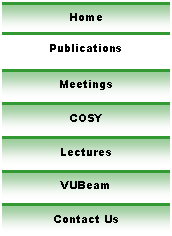
|
Reprint Server |



Optics and Nonlinear Effects in Repetitive Systems
Abstract
The weakly nonlinear dynamics in repetitive systems like synchrotrons, storage rings, linacs, and many new compact accelerators in the class of FFAGs is determined by criteria different from those in single pass optical systems. In the latter case, a clean description is obtained by the aberrations, i.e. nonlinear terms in the Taylor representation of the transfer map, and possible connections between them because of the symplectic symmetry of Hamiltonian systems or geometric symmetries of the system under consideration. For repetitive systems other criteria are relevant because conventional aberrations can be either enhanced or weakened by the repeated passage through the same system.
We begin with methods that provide highly accurate representations of fields, a pre-requisite for a detailed analysis of nonlinear motion, and discuss surface-based methods that assure accurate field representation far from midplane or axis. We then discuss methods to enforce the symplectic symmetry of the motion by minimal deformations in a suitable metric of Hamiltonian spaces, which is important in the attempt of long-term tracking of the dynamics. We then develop an analytical mechanism most closely related to the conventional aberration correction in conventional systems, the method of normal forms. As a result, quantitative measures of those linearities that matter are obtained in the form of resonance strengths and tune shifts. Residual effects can be described quantitatively using normal form defect methods, which allow rigorous predictions of long-term stability.
For practical calculations, the above methods can be expressed seamlessly in terms of differential algebraic structures on Taylor representations, either in a truncated representation in the conventional DA framework, or under consideration of remainder error terms in a fully rigorous setting.
M. Berz, K. Makino, Nuclear Instruments and Methods A645 (2011) 175-181
Download
Click on the icon to download the corresponding file.
![]() Download Adobe PDF version (403364 Bytes).
Download Adobe PDF version (403364 Bytes).
Go Back to the reprint server.
Go Back to the home page.
This page is maintained by Kyoko Makino. Please contact her if there are any problems with it.